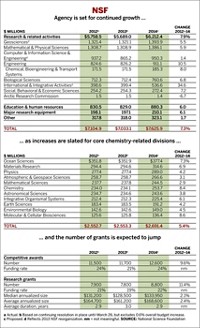Advertisement
Grab your lab coat. Let's get started
Welcome!
Welcome!
Create an account below to get 6 C&EN articles per month, receive newsletters and more - all free.
It seems this is your first time logging in online. Please enter the following information to continue.
As an ACS member you automatically get access to this site. All we need is few more details to create your reading experience.
Not you? Sign in with a different account.
Not you? Sign in with a different account.
ERROR 1
ERROR 1
ERROR 2
ERROR 2
ERROR 2
ERROR 2
ERROR 2
Password and Confirm password must match.
If you have an ACS member number, please enter it here so we can link this account to your membership. (optional)
ERROR 2
ACS values your privacy. By submitting your information, you are gaining access to C&EN and subscribing to our weekly newsletter. We use the information you provide to make your reading experience better, and we will never sell your data to third party members.
Policy
NSF: President Keeps Agency On Doubling Track
by Susan R. Morrissey
February 28, 2011
| A version of this story appeared in
Volume 89, Issue 9
COVER STORY
NSF: President Keeps Agency On Doubling Track
The President has requested $7.8 billion for the National Science Foundation in 2012. This is up 13.0% from the amount the agency is working with under the 2011 continuing resolution and keeps the agency on track to double its budget over the period 2006–17.
“This budget request reflects the confidence the President is putting in NSF,” said NSF Director Subra Suresh during a press conference. It is “designed to maintain the agency’s position as the nation’s engine of innovation in science, engineering, and science education.”
Noting that science is in an “era of observation” from large-scale planet-observing satellites to small-scale nanoscience that is leading to an “era of data and information,” Suresh said NSF is in a position to support this continuum. And although the agency would continue to provide strong support for disciplinary research, NSF would increase its efforts in observation and data analysis to tackle multidisciplinary societal problems.
One new program in this area is the Integrated NSF Support Promoting Interdisciplinary Research & Education, for which the budget provides $12 million in 2012. The program would integrate a variety of new activities with existing NSF efforts to further interdisciplinary research areas. Awards would be made to individual senior or junior investigators under this program.
Another NSF-wide program is Science, Engineering & Education for Sustainability (SEES). Started in 2011, SEES is set to receive $998 million in 2012. The aim of the effort is to advance climate and energy research and education to provide a scientific basis for shaping environmental and economic policies.
The 2012 proposal also includes $576 million for clean energy research and $76 million for the Research at the Interface of the Biological, Mathematical & Physical Sciences (BioMaPS) program. Both agencywide efforts aim to produce new techniques for clean energy and advanced manufacturing.
Education programs are also set to grow. As part of the President’s goal to produce 100,000 new STEM teachers, NSF would invest $60 million in 2012 on research to find new approaches to education.
The President’s request for 2012 terminates several programs to free up funds for various programs. For instance, the Graduate STEM Fellows in K–12 Education program would be eliminated in 2012, as would the agency’s support of the Deep Underground Science & Engineering Laboratory, which is an effort with the Department of Energy Office of Science to advance research in particle physics, nuclear physics, and astrophysics (C&EN, Oct. 4, 2010, page 38).
NSF continues its support of disciplinary research with a proposed increase for research and related activities of 12.4%, for a 2012 total budget of $6.3 billion. The Directorate for Mathematical & Physical Sciences (MPS) is slated to get $1.4 billion, or 6.0% above the estimated 2011 budget.
Within MPS, the Chemistry Division is set to see a 10.4% jump in its budget, bringing its total budget to $258 million. The Division of Materials Research would also grow—climbing 6.0% to $321 million for 2012.
Among MPS priorities is investing in NSF-wide initiatives. This includes directorate contributions of $160 million to SEES-related activities and $26 million to BioMaPS-related activities.







Join the conversation
Contact the reporter
Submit a Letter to the Editor for publication
Engage with us on Twitter